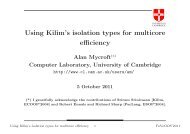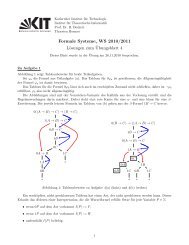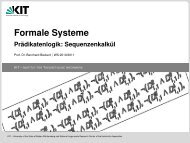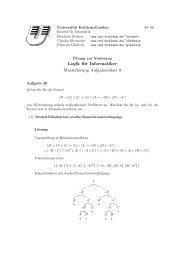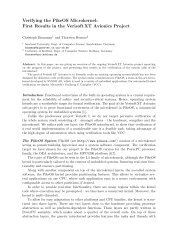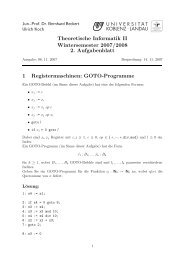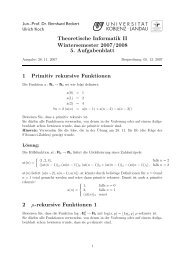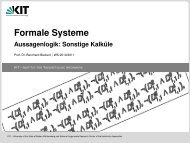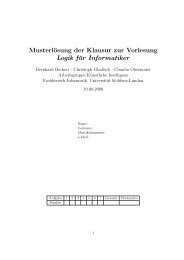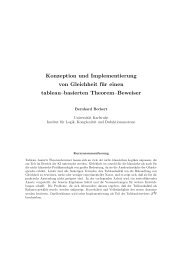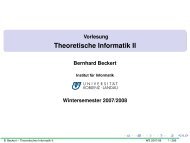Deductive Verification of System Software in the Verisoft XT Project
Deductive Verification of System Software in the Verisoft XT Project
Deductive Verification of System Software in the Verisoft XT Project
Create successful ePaper yourself
Turn your PDF publications into a flip-book with our unique Google optimized e-Paper software.
While most SMT solvers handle only quantifier-free, decidable<br />
logics, Z3 is also capable <strong>of</strong> solv<strong>in</strong>g problems with quantified<br />
formulas. Universal quantification is handled ei<strong>the</strong>r with <strong>in</strong>complete<br />
<strong>in</strong>stantiation heuristics, complete model-based <strong>in</strong>stantiation<br />
or with superposition based calculi. VCC uses only <strong>the</strong> first<br />
method, due to performance reasons.<br />
We shall now go through a simple program, how its correctness<br />
is encoded as an SMT formula, and how <strong>the</strong> SMT solver<br />
checks its satisfiability.<br />
1 void compute_abs ( <strong>in</strong>t *x)<br />
2 { if (*x < 0)<br />
3 *x = -(*x);<br />
4 assert (*x >= 0); }<br />
For brevity we skip pro<strong>of</strong> obligations stemm<strong>in</strong>g from check<strong>in</strong>g<br />
validity <strong>of</strong> memory accesses, so by correctness <strong>of</strong> <strong>the</strong> program we<br />
mean that <strong>the</strong> explicit assertion never fails. VCC generates <strong>the</strong><br />
follow<strong>in</strong>g three formulas. The unsatisfiability <strong>of</strong> <strong>the</strong> conjunction<br />
<strong>of</strong> <strong>the</strong>m implies <strong>the</strong> correctness <strong>of</strong> <strong>the</strong> program.<br />
∀H, p, v. rd(wr(H, p, v), p) = v (1)<br />
(rd(H0, x) < 0 ∧ H1 = wr(H0, x, −rd(H0, x))) ∨<br />
(¬(rd(H0, x) < 0) ∧ H1 = H0)<br />
(2)<br />
¬(rd(H1, x) ≥ 0) (3)<br />
The first conjunct (1) is one <strong>of</strong> <strong>the</strong> axioms describ<strong>in</strong>g <strong>the</strong> behavior<br />
<strong>of</strong> <strong>the</strong> heap: if one writes v at heap location p, <strong>the</strong>n read<strong>in</strong>g<br />
from <strong>the</strong> updated heap at p will yield v. There are more axioms<br />
describ<strong>in</strong>g <strong>the</strong> heap, as well as a few hundred o<strong>the</strong>r axioms encod<strong>in</strong>g<br />
<strong>the</strong> rest <strong>of</strong> <strong>the</strong> VCC verification methodology, which are<br />
not needed for this example. The second conjunct (2) encodes<br />
<strong>the</strong> semantics <strong>of</strong> <strong>the</strong> if statement: ei<strong>the</strong>r <strong>the</strong> condition was true,<br />
and <strong>the</strong> new heap is constructed by updat<strong>in</strong>g <strong>the</strong> old heap at x,<br />
or <strong>the</strong> condition was not true, and <strong>the</strong> new heap equals <strong>the</strong> old<br />
heap. F<strong>in</strong>ally, conjunct (3) says that <strong>the</strong> assertion is violated.<br />
A model for <strong>the</strong> conjunction <strong>of</strong> <strong>the</strong> three formulas corresponds<br />
to a program execution where <strong>the</strong> assertion is violated. If such<br />
a model does not exists (i.e., <strong>the</strong> formula is unsatisfiable), <strong>the</strong>n<br />
<strong>the</strong> program is correct.<br />
Let us now exam<strong>in</strong>e how <strong>the</strong> SMT solver establishes unsatisfiability<br />
<strong>of</strong> <strong>the</strong> conjunction. Generally, at first it ignores function<br />
symbols and quantified subformulas, and looks for a propositionally<br />
satisfy<strong>in</strong>g truth assignment to <strong>the</strong> atoms (where by atoms<br />
we mean applications <strong>of</strong> predicates and quantified subformulas)<br />
<strong>of</strong> <strong>the</strong> formula. Assume <strong>the</strong> first assignment <strong>the</strong> solver considers<br />
is to make <strong>the</strong> quantified formula (1) and H1 = H0 true and to<br />
make rd(H0, x) < 0 and rd(H1, x) ≥ 0 false. The un<strong>in</strong>terpreted<br />
function decision procedure (DP) 1 <strong>in</strong>fers rd(H0, x) = rd(H1, x)<br />
based on H1 = H0. The l<strong>in</strong>ear arithmetic DP perspective on<br />
this is ¬(a < 0) and ¬(b ≥ 0) (where a and b are abstractions<br />
<strong>of</strong> rd(H0, x) and rd(H1, x) respectively, <strong>the</strong> arithmetic<br />
DP is not concerned about <strong>the</strong>ir <strong>in</strong>ternal structure), and now<br />
it receives <strong>the</strong> literal a = b, and says that <strong>the</strong> result<strong>in</strong>g set<br />
<strong>of</strong> literals is unsatisfiable. Such situations, where <strong>the</strong> current<br />
literal assignment is unsatisfiable, are called a conflict. Then,<br />
1 Everyth<strong>in</strong>g that is not pure equality and propositional connectives<br />
is treated as <strong>the</strong>ory <strong>in</strong> SMT. This <strong>in</strong>cludes <strong>the</strong> un<strong>in</strong>terpreted function<br />
<strong>the</strong>ory, which could be axiomatized with ∀x1, ..., xn, y1, ..., yn.x1 =<br />
y1 ∧ ... ∧ xn = yn ⇒ f(x1, ..., xn) = f(y1, ..., yn) for every function<br />
symbol f with arity n.<br />
<strong>the</strong> DPs narrow down <strong>the</strong> subset <strong>of</strong> currently assigned literals,<br />
that actually participate <strong>in</strong> <strong>the</strong> conflict. A disjunction <strong>of</strong> negations<br />
<strong>of</strong> those literals is called conflict clause and is a tautology<br />
modulo background <strong>the</strong>ories. In our case <strong>the</strong> conflict clause is:<br />
rd(H0, x) < 0 ∨ ¬(H1 = H0) ∨ rd(H1, x) ≥ 0. Because <strong>the</strong><br />
conflict clause is a tautology, conjo<strong>in</strong><strong>in</strong>g it to <strong>the</strong> <strong>in</strong>put formula<br />
does not change <strong>the</strong> satisfiability status <strong>of</strong> <strong>the</strong> <strong>in</strong>put formula.<br />
After we conjo<strong>in</strong> it, <strong>the</strong> search space narrows down: a class <strong>of</strong><br />
literal assignments, <strong>in</strong>clud<strong>in</strong>g <strong>the</strong> current one, is propositionally<br />
excluded. In our case, <strong>the</strong> only rema<strong>in</strong><strong>in</strong>g possible propositional<br />
assignment for our formula is to make <strong>the</strong> quantified formula (1),<br />
rd(H0, x) < 0, and H1 = wr(H0, x, −rd(H0, x)) true, and to<br />
make rd(H1, x) ≥ 0 false. These literals do not conflict at <strong>the</strong><br />
ground level, and thus <strong>the</strong> quantified formula is <strong>in</strong>stantiated.<br />
The follow<strong>in</strong>g tautology is conjo<strong>in</strong>ed to <strong>the</strong> orig<strong>in</strong>al formula:<br />
(∀H, p, v. rd(wr(H, p, v), p) = v) ⇒<br />
rd(wr(H0, x, −rd(H0, x)), x) = −rd(H0, x)<br />
The propositional assignment is <strong>the</strong>n extended to make <strong>the</strong> literal<br />
rd(wr(H0, x, −rd(H0, x)), x) = −rd(H0, x) true, which is<br />
<strong>the</strong> only way to satisfy <strong>the</strong> implication above. The un<strong>in</strong>terpreted<br />
function DP <strong>in</strong>fers ¬(−rd(H0, x) ≥ 0), and <strong>the</strong> l<strong>in</strong>ear arithmetic<br />
view <strong>of</strong> a < 0 and ¬(−a ≥ 0) generates a conflict clause, which<br />
blocks <strong>the</strong> only rema<strong>in</strong><strong>in</strong>g propositional assignment. The formula<br />
is thus deemed unsatisfiable.<br />
This description <strong>of</strong> <strong>the</strong> pro<strong>of</strong> search highlights <strong>the</strong> most important<br />
features <strong>of</strong> SMT solvers. (1) Handl<strong>in</strong>g <strong>of</strong> <strong>the</strong> propositional<br />
structure <strong>of</strong> <strong>the</strong> formula is very much like <strong>in</strong> <strong>the</strong> modern,<br />
extremely efficient, propositional SAT solvers. (2) Multiple DPs<br />
build <strong>in</strong>to <strong>the</strong> SMT solvers need to cooperate, <strong>in</strong> our example<br />
<strong>the</strong> un<strong>in</strong>terpreted function DP propagated equality to <strong>the</strong> l<strong>in</strong>ear<br />
arithmetic DP. (3) The search space is narrowed by <strong>the</strong> conflict<br />
clauses that <strong>the</strong> SMT solver learns dur<strong>in</strong>g <strong>the</strong> search. (4) The<br />
quantified formulas are handled by <strong>in</strong>stantiation and, <strong>the</strong>refore,<br />
we need some heuristic to decide how to <strong>in</strong>stantiate.<br />
The heuristic which we use <strong>in</strong> Z3 for VCC is based on Ematch<strong>in</strong>g.<br />
2 Certa<strong>in</strong> subterms <strong>of</strong> <strong>the</strong> quantified formula body are<br />
designated as triggers. The SMT solver searches for substitutions,<br />
which make <strong>the</strong> triggers equal to some subterms <strong>of</strong> currently<br />
assigned ground literals, <strong>in</strong> hope that an <strong>in</strong>stance shar<strong>in</strong>g<br />
subterms with <strong>the</strong> current ground problem will be relevant for<br />
<strong>the</strong> search. For example, let us assume <strong>the</strong> trigger for <strong>the</strong> heap<br />
axiom is rd(wr(H, p, v), p). At <strong>the</strong> moment, where we needed<br />
<strong>the</strong> <strong>in</strong>stantiation, <strong>the</strong> ground literals <strong>in</strong>cluded ¬(rd(H1, x) ≥ 0)<br />
and H1 = wr(H0, x, −rd(H0, x))). If we take<br />
<strong>the</strong>n<br />
σ = [H := H0, p := x, v := −rd(H0, x)] ,<br />
σ(rd(wr(H, p, v), p)) = rd(H1, x) ,<br />
because H1 = wr(H0, x, −rd(H0, x))) (we thus consider <strong>the</strong><br />
currently assumed equality atoms).<br />
The triggers can be ei<strong>the</strong>r explicitly supplied to <strong>the</strong> SMT<br />
solver, or <strong>the</strong> solver can select <strong>the</strong>m us<strong>in</strong>g a simple heuristic.<br />
The explicit trigger<strong>in</strong>g has proven to be a powerful, if somewhat<br />
arcane, tool for build<strong>in</strong>g custom SMT <strong>the</strong>ories, like <strong>the</strong> one describ<strong>in</strong>g<br />
a particular verification methodology [9, 10, 2, 12]. The<br />
2 The E <strong>in</strong> “E-match<strong>in</strong>g”stands for equality.



